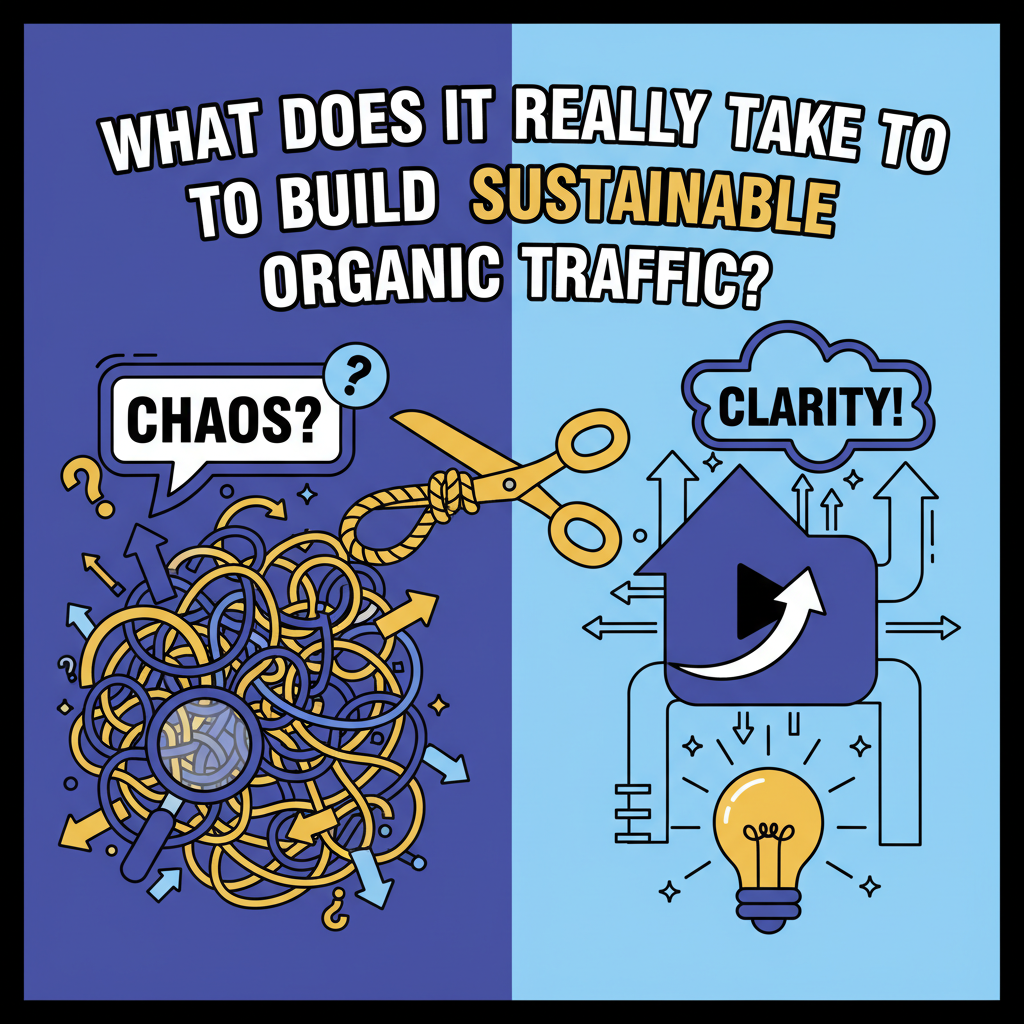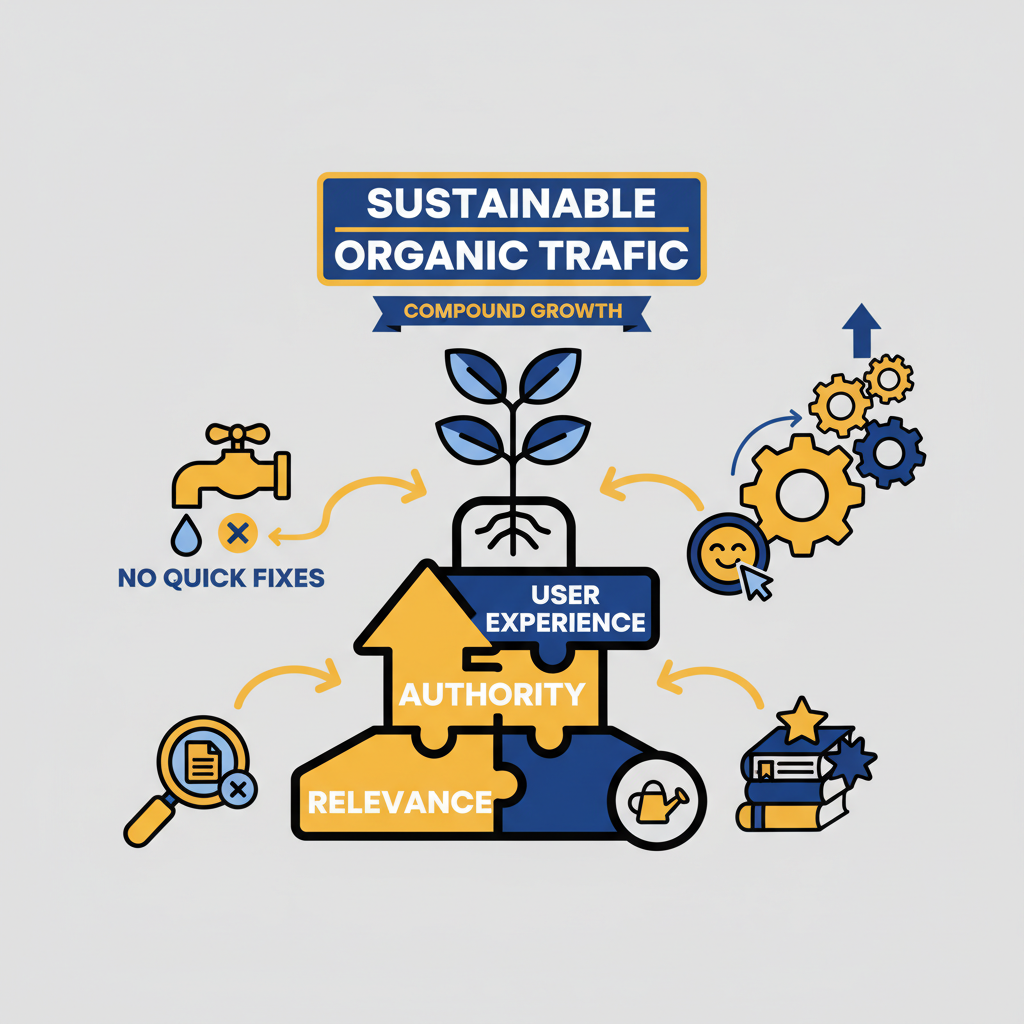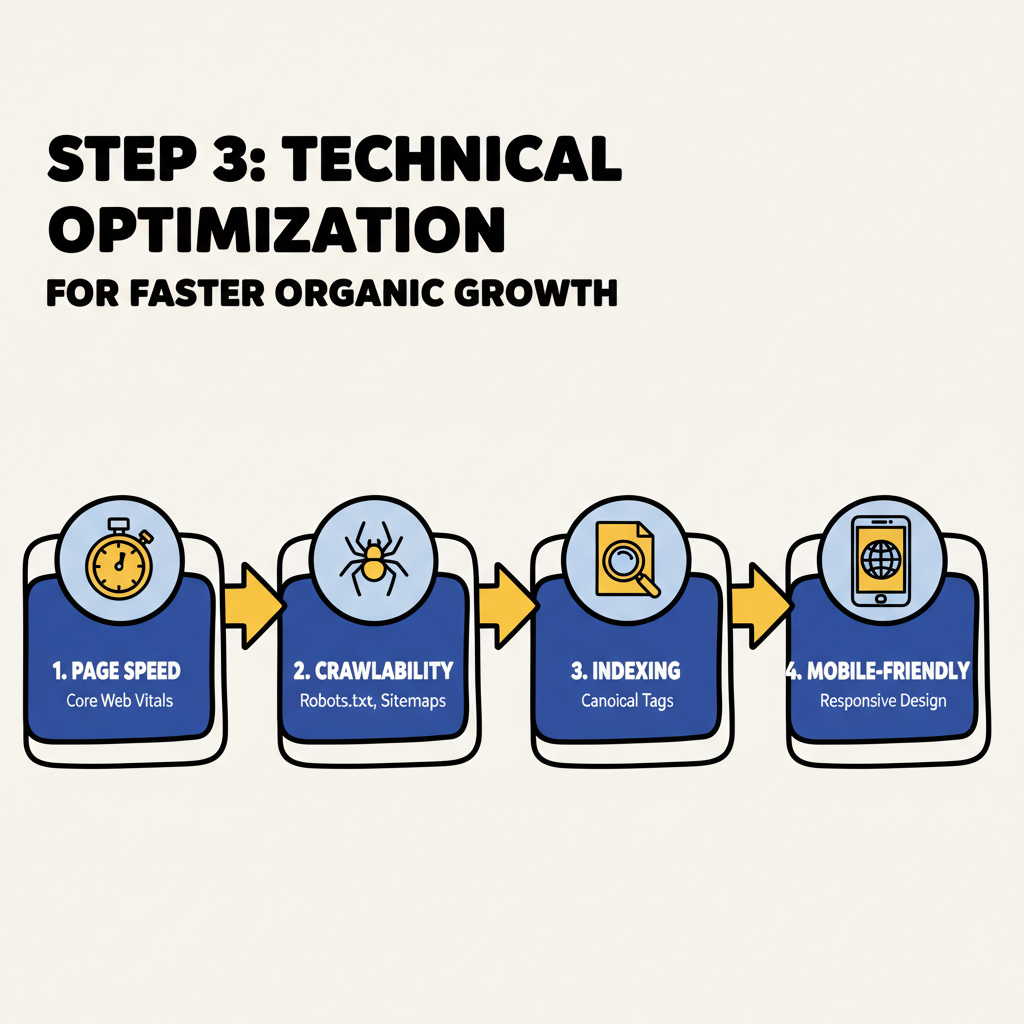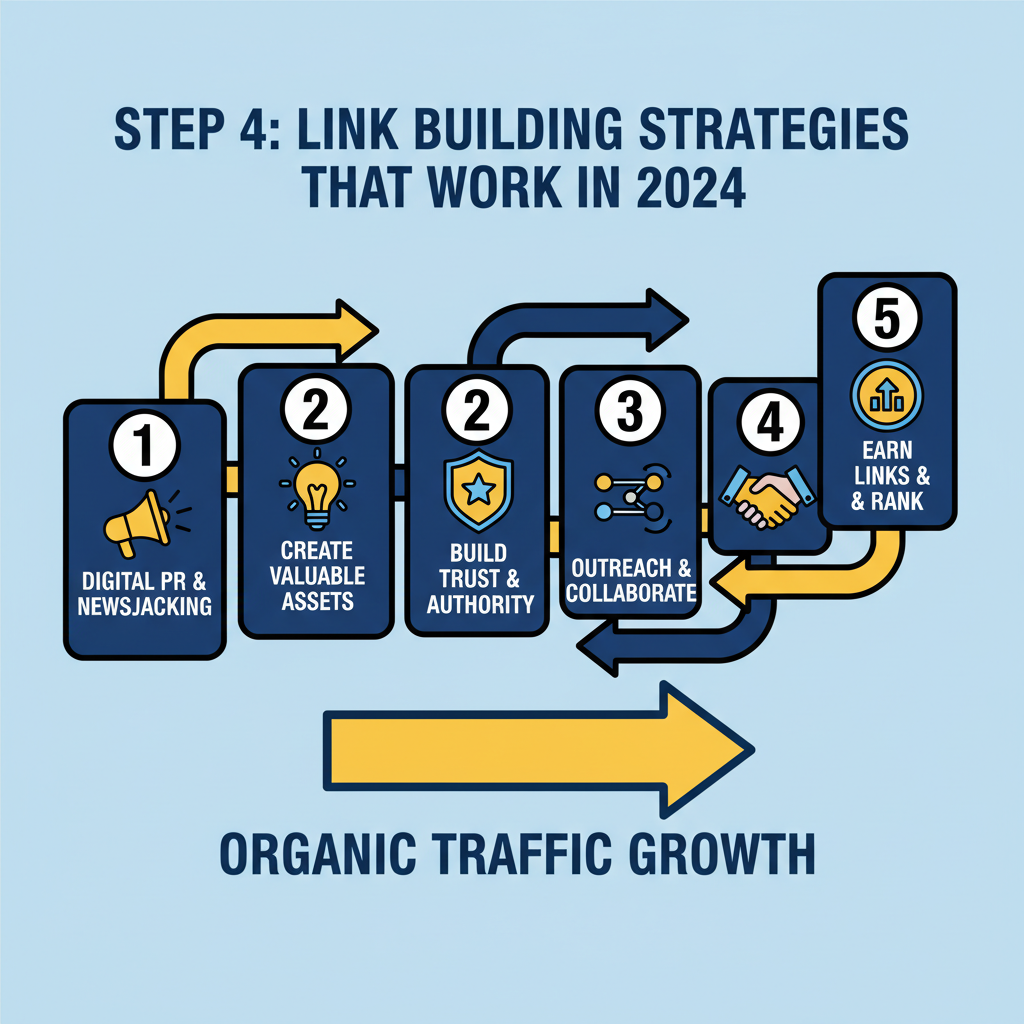What Does It Really Take to Build Sustainable Organic Traffic?
Posted by
Related reading
Understanding the Fast SEO Methodology
How to Implement Fast SEO Strategies That Deliver Results in 30 Days In today's hyper-competitive digital landscape, waiting months for SEO results is no longer...
What Makes an Organic Traffic Growth System Different?
How to Build an Organic Traffic Growth System That Delivers Results Building a sustainable organic traffic system requires more than just publishing content and...
What is Organic Traffic and Why Should You Prioritize It?
Organic Traffic: Complete Guide for 2025 The digital landscape has shifted dramatically, and organic traffic remains the holy grail of sustainable online succes...
How to Skyrocket Your Organic Traffic in 90 Days: A Data-Driven Blueprint

Struggling to grow your website's organic traffic? You're not alone. While paid advertising can deliver instant results, organic traffic remains the most sustainable and cost-effective way to build long-term online success. The challenge is that most website owners don't have a systematic approach to growing their organic reach.
In this comprehensive guide, you'll discover a proven 90-day blueprint for dramatically increasing your organic traffic. We'll walk through each step of the process, from conducting strategic keyword research to optimizing your content for maximum search visibility. By the end, you'll have a clear roadmap to transform your website into an organic traffic magnet.
What Does It Really Take to Build Sustainable Organic Traffic?

Building organic traffic isn't about quick fixes or overnight success. It requires a strategic approach that focuses on three core pillars: relevance, authority, and user experience. Unlike paid traffic that stops the moment you stop spending, organic traffic builds compound growth over time.
The key difference between websites that succeed and those that struggle lies in their approach to content strategy. Successful sites don't just create content; they create content that directly addresses their audience's search intent while establishing topical authority in their niche.
According to Ahrefs' study of 2 million keywords, it takes an average of 2-6 months for new pages to rank in Google's top 10 results. However, with the right strategy, you can accelerate this timeline significantly.
Step 1: How to Conduct Strategic Keyword Research for Maximum Impact
Your organic traffic growth starts with understanding exactly what your audience is searching for. This goes beyond basic keyword tools and requires a deep dive into search intent and competition analysis.
Begin by identifying your primary topic clusters. These are broad themes that encompass multiple related keywords your audience might use. For each cluster, you'll want to target one primary keyword and several supporting long-tail variations.
Use tools like Google's Keyword Planner or SEMrush to analyze search volume and competition levels. However, don't just focus on high-volume keywords. Often, medium and low-volume keywords with clear commercial intent can drive more qualified organic traffic to your site.
How to Identify Low-Competition, High-Value Keywords
The secret to fast SEO results lies in finding keyword opportunities your competitors have missed. Look for keywords with search volumes between 500-2,000 monthly searches and keyword difficulty scores below 30.
Pay special attention to question-based keywords and "how-to" phrases. These often have lower competition but higher conversion rates because they target users actively seeking solutions.
Step 2: Creating Content That Dominates Search Results
Once you've identified your target keywords, the next step is creating content that not only ranks but converts visitors into customers. This requires understanding the difference between content that gets traffic and content that gets results.
Start by analyzing the top 10 results for your target keywords. What topics do they cover? What questions do they answer? More importantly, what gaps exist that you can fill with superior content?
Your content should be comprehensive without being overwhelming. Aim for depth over length, ensuring every paragraph adds genuine value for your readers. Understanding what makes organic SEO different from generic approaches can help you create content that stands out in crowded search results.
The EEAT Framework for Building Content Authority
Google's EEAT (Experience, Expertise, Authoritativeness, Trustworthiness) framework should guide your content creation process. Demonstrate your experience through case studies and real examples. Show expertise by diving deep into technical details. Build authority through original research and unique insights. Establish trust with transparent sourcing and author credentials.
Step 3: Technical Optimization for Faster Organic Growth

Technical SEO forms the foundation of your organic traffic strategy. Even the best content won't rank if search engines can't properly crawl and index your pages.
Start with page speed optimization. According to Google's Core Web Vitals study, pages that meet all Core Web Vitals thresholds have 24% lower abandonment rates. Use tools like Google PageSpeed Insights to identify and fix speed issues.
Next, ensure your site structure supports both user navigation and search engine crawling. Implement a logical URL structure, create an XML sitemap, and use internal linking to distribute page authority throughout your site.
| Technical Factor | Impact on Organic Traffic | Implementation Priority |
|---|---|---|
| Page Speed | High - affects rankings and user experience | Critical |
| Mobile Responsiveness | High - mobile-first indexing | Critical |
| SSL Certificate | Medium - trust signal | High |
| Schema Markup | Medium - enhanced search results | Medium |
| Internal Linking | High - distributes page authority | High |
How to Leverage Content Clusters for Maximum Organic Reach
Content clustering is one of the most effective strategies for building topical authority and increasing organic traffic across multiple related keywords. Instead of creating isolated blog posts, you'll develop comprehensive content ecosystems that demonstrate your expertise in specific subject areas.
Start by identifying your main pillar topics. These should be broad subjects central to your business that have substantial search volume. For each pillar topic, create a comprehensive cornerstone piece of content that covers the topic thoroughly.
Then, develop cluster content that explores specific subtopics in detail. Each cluster piece should link back to your pillar content and to other relevant cluster pieces. This internal linking structure helps search engines understand the relationship between your content pieces and can significantly boost your rankings for related keywords.
Building Authority Through Comprehensive Coverage
The websites that achieve the highest organic traffic don't just cover topics superficially. They become the go-to resource for their entire subject area. This means creating content that addresses every aspect of your audience's journey, from initial awareness to final purchase decision.
Map out your customer's search journey and create content for each stage. Early-stage content might focus on educational topics and problem identification. Middle-stage content could compare solutions and explain methodologies. Late-stage content should address specific product questions and implementation details.
How to Optimize for Featured Snippets and Voice Search
Featured snippets represent position zero in search results and can dramatically increase your organic traffic overnight. These coveted spots often receive 35-40% of all clicks for their target keywords.
To optimize for featured snippets, structure your content to directly answer common questions. Use clear headings that mirror the questions people ask, then provide concise, comprehensive answers immediately following each heading.
Voice search optimization requires a slightly different approach. Voice queries tend to be longer and more conversational than typed searches. Focus on natural language patterns and question-based keywords that people might speak aloud.
According to BrightEdge research, 58% of consumers use voice search to find local business information. If you serve local markets, ensure your content includes location-specific information and answers local search queries.
Step 4: Link Building Strategies That Actually Work in 2024

Link building remains one of the strongest ranking factors for organic traffic growth. However, the strategies that worked five years ago can now harm your rankings. Modern link building focuses on earning links through value creation rather than manipulation.
Start with digital PR and newsjacking opportunities. Create original research, conduct industry surveys, or provide expert commentary on trending topics in your field. These approaches naturally attract high-quality backlinks from authoritative sources.
Resource page link building still works when done correctly. Instead of mass-emailing generic requests, identify specific resource pages where your content genuinely adds value. Craft personalized outreach messages that explain exactly how your content benefits their audience.
How to Turn Competitor Analysis into Link Opportunities
Your competitors' backlink profiles contain a roadmap to link opportunities in your industry. Use tools like Ahrefs or SEMrush to analyze where your top competitors are getting links, then develop strategies to earn links from similar sources.
Look for patterns in their link profiles. Do they frequently get links from industry publications? Are they mentioned in roundup posts? Do they have partnerships with complementary businesses? Each pattern represents a potential opportunity for your own link building efforts.
Measuring and Accelerating Your Organic Traffic Growth
Tracking the right metrics is crucial for understanding whether your organic traffic efforts are paying off. While total organic traffic is important, focus on metrics that directly correlate with business results.
Monitor your organic click-through rates from search results. Low CTRs often indicate that your title tags and meta descriptions need optimization, even if your rankings are strong. Similarly, track your organic traffic's bounce rate and time on page to ensure you're attracting qualified visitors.
Set up conversion tracking for your organic traffic segments. Not all organic traffic is created equal, and understanding which keywords and content pieces drive actual business results helps you prioritize future optimization efforts.
Use Google Search Console to identify your "almost ranking" keywords. These are terms where you rank on the second page of search results. Often, minor optimizations to these pages can push them onto the first page, resulting in significant organic traffic increases.
Conclusion
Growing organic traffic requires patience, strategy, and consistent execution. The 90-day blueprint outlined in this guide provides a systematic approach to building sustainable organic growth for your website.
Remember that organic traffic is a long-term investment that compounds over time. The content you create today will continue driving traffic months and years into the future. Focus on creating genuine value for your audience, and the search engines will reward you with increased visibility and organic traffic.
Ready to implement these strategies but need expert guidance? Discover how automated SEO solutions can accelerate your organic traffic growth while you focus on creating exceptional content.